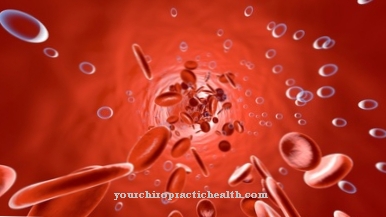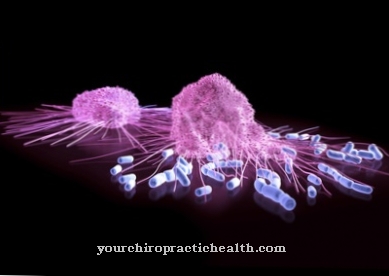force or a good strength ability plays an important role in many sports and in numerous everyday activities. Some diseases can significantly limit them.
What is power

In sports science, performance is divided into 5 basic motor characteristics. In addition to speed, endurance, coordination and flexibility, strength is one of them. It can be divided into various types of stress.
The term maximum force is one of them and describes the ability of the muscular system to apply the maximum possible force against an insurmountable resistance. The size of the force depends on the muscle cross-section. The term rapid strength defines the ability to generate the greatest possible movement impulse in the shortest possible time. This property is largely determined by the fiber composition of the muscles. With reactive force is meant the ability of the motor system to use the potential energy for the execution of movements that arise during the so-called stretching-shortening cycle.
All properties only work optimally if the nerve-muscle interaction and the metabolic systems are intact and sufficient energy is provided.
Force arises in the muscle through a contraction, which either results in movement or leads to an increase in tension in the muscle. Accordingly, it can be classified into a dynamic and a static form. The dynamic concentric form of contraction is characterized by the fact that the muscle shortens during the contraction. With the dynamically eccentric shape, the origin and attachment move away during muscular work. In the isometric shape, which is also possible, the length does not change.
Function & task
The force that results from the summation of all contractions in the muscle cells is used either for stabilization, for local movements or to move the entire body, such as when walking or running. Resistances, such as those that arise when lifting loads or pushing away weights, increase the effort required. In everyday life the situation often occurs that the core of the body is stabilized while the extremities are moving. This sensible functional distribution of tasks enables the dynamics of the body.
Strength is required in many everyday, manual and sporting activities. In classic professions with heavy physical work, such as bricklayers, scaffolders, roofers or blacksmiths, high levels of strength are repeatedly required. The specific strength properties of the people who work in this area are significantly improved over time.
In many sports, good strength skills play an important role, either as a component in addition to other basic motor properties, or as a main aspect. Weightlifters and other strength athletes need good maximum strength values and stabilization skills, while in dynamic sports disciplines, the other strength components are more required, especially speed.
The reactive force is very important in all sports that are associated with back-swinging movements. The start of the movement can be made much more effective by using the kinetic energy that has been stored in the elastic elements of the movement system through the pre-stretching. This is the case in all sports that involve swinging movements, such as handball and volleyball, the setback games tennis, squash and badminton and the athletic throwing disciplines discus, hammer and javelin throwing. As part of the development of the fitness area, strength training has meanwhile become a separate sporting discipline that many people practice in the studio, in the club or at home.
Dynamic strength training can be divided into different types, which are used depending on personal goals or the needs of the respective sport. The classification is based on the required intensity of the force demand, which is measured using the maximum force value. The training takes place in series with repetitions and breaks between the individual sets. The higher the required intensity, the smaller the number of repetitions and the longer the pause time.
Strength endurance training improves the ability to perform movements with medium weights or resistance for longer periods of time, while hypertrophy and maximum strength training is more about building strength. The training of neuromuscular coordination is the form of stress with the highest intensity.
You can find your medication here
➔ Medicines for muscle weaknessIllnesses & ailments
Any illness associated with a loss or reduction in strength skills interferes with the activities that require strength. Muscle atrophy is a symptom of muscle breakdown that occurs after prolonged periods of inactivity. This process can occur locally after a long period of immobilization of a body part, for example in a cast. But it can also affect the entire skeletal muscles, as a result of prolonged immobility due to serious illnesses or injuries.
The intensity of the breakdown determines the time it takes to rebuild the muscles. In general, however, it can be said that muscle loss takes place very quickly, but the build-up takes significantly longer.
All neurological problems that lead to incomplete or complete flaccid paralysis of muscles cause a significant reduction or a total loss of the strength capabilities of the affected muscle. These diseases include peripheral lesions that are caused by injuries, pressure damage or diseases of the nerves. Accidents, stab wounds or cuts can cause direct local nerve damage, while excessively tight plaster casts or herniated discs lead to indirect damage from pressure.
Nerves of the extremities are most often affected by such processes, since they are relatively superficial. Typical examples are the lesions of the radial nerve with the appearance of the drop hand or the median nerve with the hand of oath on the arm. The most common injury to the peroneal nerve occurs on the leg, with paralysis of the foot lifters.
A serious injury with massive consequences is the mostly traumatic severing of the spinal cord with complete or incomplete paraplegia. All muscles that are supplied by the nerves that are below the cross-section can, depending on the severity, develop little or no strength. Everyday activities such as walking or hand activities can be massively restricted or even impossible.
Muscular dystrophies and amyotrophic lateral sclerosis are a group of rare diseases that lead to a progressive loss of muscle function and strength. These are systemic disorders that result in a more or less rapid reduction in the strength of the entire skeletal muscles. With rapid processes, the quality of life and social participation are very quickly impaired. These diseases can significantly reduce life expectancy.



























